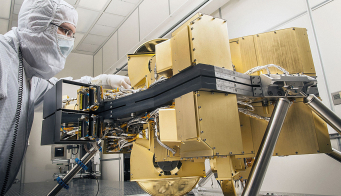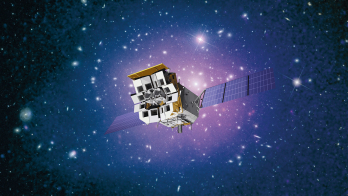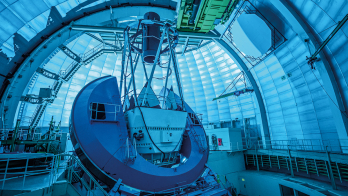Twin imaging air-Cherenkov telescopes on La Palma peer deep into the gamma-ray universe.
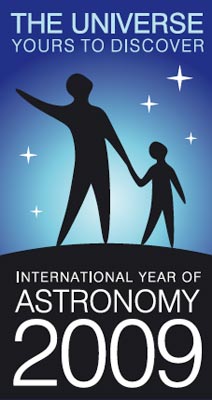
In a simple ceremony on a mountaintop under blue skies and bright sunlight on 25 April, a small group of colleagues, family and friends paused in silence in memory of a young physicist who died there last September. Florian Goebel suffered a fatal accident while putting the finishing touches to the MAGIC-II telescope at the Roque de Los Muchachos Observatory on the Canary Island of La Palma. He had been the project manager and it is fitting that the two MAGIC telescopes were named the Florian Goebel Telescopes at the ceremony. Shortly afterwards, Florian’s brother helped to cut the white, blue and yellow ribbons that symbolically held the telescope, releasing it for its “first light”.
MAGIC-II thus joined its older sibling, MAGIC-I, in exploring the gamma-ray sky, each with a larger segmented mirror than any other reflecting telescope. While MAGIC-I has already made major discoveries, together the two telescopes will make simultaneous observations and achieve a sensitivity three times greater than when working independently.
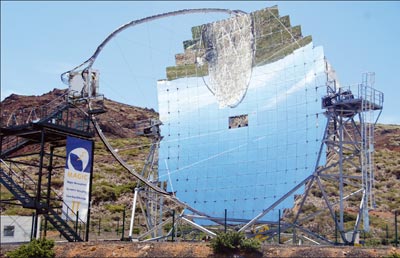
The Major Atmospheric Gamma-Ray Imaging Cherenkov (MAGIC) project is one of four around the world that use reflecting telescopes to detect the short bursts of Cherenkov light emitted by the showers of charged particles produced when a high-energy gamma ray interacts in the Earth’s upper atmosphere. The High Energy Stereoscopic System (HESS) has been operating in the highlands of Namibia since September 2004; the Very Energetic Radiation Imaging Telescope Array System (VERITAS) in Arizona began it first observations in 2003; and the CANGAROO collaboration between Australia and Japan, which has been observing gamma-ray sources since 1992, began full operation of its most recent telescopes in 2004.
A textbook example

Gamma-rays reveal the highest-energy phenomena in the universe, but a major goal for MAGIC is to extend observations to lower gamma-ray energies, which will allow it to see deeper into the universe and farther back in time. At lower energies, the gamma rays are less likely to interact with other light on their long journey through space.
The story of the MAGIC project is a textbook example of the merging of particle physics and astronomy into the modern field of astroparticle physics. For many years, Eckart Lorenz from MPI Munich was a familiar face at CERN and other particle physics laboratories, working in a number of well known collaborations involving the Munich group. By the 1990s he began to apply his expertise in particle-detection techniques to the study of high-energy cosmic gamma rays, in particular by using imaging atmospheric Cherenkov telescopes.
Detecting the Cherenkov light emitted as charged particles pass through a medium faster than light does is a well known technique in particle physics. The method is used to identify charged particles according to their velocities, as implemented for example in the LHCb experiment at CERN. The radiation forms a cone about the particle’s path; the angle of the cone depends on the refractive index of the medium, n, and the particle’s velocity, v. The higher the velocity, the larger the angle, θ, with cosθ = c/nv, where c is the speed of light in free space. For Cherenkov telescopes the medium used is the Earth’s atmosphere, and in gamma-ray showers the particles are primarily electrons and positrons travelling close to the limiting velocity, c.
The showers develop to contain a maximum number of particles around 10 km above sea level; the Cherenkov light that they emit forms a “disc” typically a metre or so thick, with a diameter of about 250 m when it arrives at the Earth’s surface. This disc of light is like an image of the shower. It contains essential information about the direction and the energy of the original gamma-ray and – because gamma-rays are uninfluenced by magnetic fields in space – in effect points back to the gamma-ray source.
An imaging atmospheric Cherenkov telescope with its axis pointing in the direction of the source will intercept a small part of the disc of Cherenkov light and form an image of it at the focal point. The main challenge lies in detecting very low intensity light at the level of single photons, because the Cherenkov radiation from the shower is spread across the whole disc. Moreover, the showers from charged primary cosmic rays (hadrons, mainly protons) produce a substantial background with a rate some 10,000 times greater than that of gamma-ray-induced showers. Fortunately, the shape and structure of the two types of shower differ sufficiently for the image in the telescope to have different characteristics. Appropriate image-analysis techniques can ultimately reject the unwanted hadronic showers.
Bridging the energy gap
The Cherenkov radiation from cosmic-ray showers constitutes only about 0.01% of the light in the night sky – but it is detectable, as Bill Galbraith and John Jelley first showed at Harwell in the UK in 1953 with not much more than a dustbin with a 60 cm diameter mirror and a photomultiplier tube (PMT) at its focus. Using the same principle each MAGIC telescope, with its diameter of 17 m, has an array of hundreds of PMTs at the focus – 576 in the case of MAGIC-I and 1039 for MAGIC-II.
The potential for observing cosmic gamma-ray sources through the detection of air showers was first suggested in 1959 by Giuseppe Cocconi, who also proposed that the Crab nebula should be a strong source of high-energy gamma rays. This inspired Aleksandr Chudakov to build a pioneering Cherenkov telescope in Crimea in the early 1960s. It took 30 years before Trevor Weekes and colleagues could finally claim observation of the Crab with the Whipple imaging air Cherenkov telescope in 1989. With its 10 m segmented mirror viewed by an array of PMTs, Whipple pioneered the use of this technique in studies of the gamma-ray sky at energies from around 100 GeV to 10 TeV. It discovered the first source of gamma rays beyond our galaxy, with the detection of very high-energy emission from the active galaxy Markarian 421 (Mkn 421).
Around the same time the High-Energy Gamma-Ray Astronomy (HEGRA) project was also observing air showers with a range of detectors at the Roque de Los Muchachos Observatory. These included five atmospheric Cherenkov telescopes, each with an area of 8.5 m2, which operated in coincidence to achieve better angular resolution and a much improved rejection of background, in particular from hadron showers. The system successfully detected gamma rays up to more than 10 TeV in energy, emitted by the active galactic nuclei Mkn 421 and Mkn 501, which are prime examples of the variable and intense gamma-ray sources known as “blazars”.
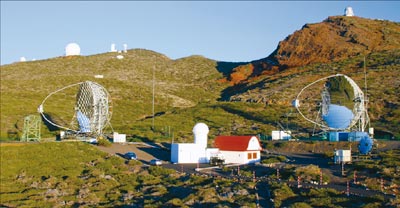
While Whipple and HEGRA searched for sources of very high-energy gamma rays, the Energetic Gamma Ray Emission Telescope (EGRET) on board NASA’s Compton Gamma Ray Observatory was collecting a wealth of data on the gamma-ray sky at lower energies, from 20 MeV to 10 GeV. Being above the Earth’s atmosphere it could detect gamma-rays directly. However, with a small detection area and because the number of gamma rays per unit area falls steeply with energy, a small detector becomes inefficient at higher energies, with a practical limit of about 10 GeV.
It was around this time that Lorenz, who was a member of the HEGRA project, began to dream of bridging the gap in energy accessed by the ground-based and space-based instruments. This would require a larger-area mirror to collect more light, making it more sensitive to showers from the gamma rays below 100 GeV; the minimum detectable energy varies more or less inversely with the area of the mirror. At first the idea did not seem too promising because a large telescope looked likely to cost as much as a satellite. However, Lorenz and colleagues discovered that the German solar-power research programme had built a 17 m reflector dish using a relatively simple construction – and the first ideas for the MAGIC telescope were soon sketched out in a Munich beer garden.
Making MAGIC
The main features of the 17 m telescope for MAGIC were clear from the outset. It had to be lightweight to react and move quickly in searches for gamma-ray bursts (GRBs) – the puzzling, powerful phenomena discovered some 30 years ago. At the same time the structure had to be rigid enough to avoid deformations. The chosen solution was to build a framework of carbon-fibre tubes and the reflector was constructed of light-weight aluminium mirrors, with diamond-machined surfaces and an active control system to adjust each mirror to counteract any small deformations arising in the frame. In addition, the aim was to use the telescope to collect as much data as possible; on moonlit nights and at large zenith angles, close to the horizon, where the Cherenkov radiation reddens, like sunlight, as it travels farther through the atmosphere to the detector. This would require novel phototubes with high quantum efficiency to improve on the light collection and to increase sensitivity

Lorenz first presented MAGIC publicly at the International Cosmic Ray Conference in Rome in 1995. The project had many new ideas – possibly too many. It initially met with resistance: critics said that the construction was too light and it would blow over; the carbon fibre would be too expensive and so on. However, there were supporters such as the Italian National Institute for High Energy Physics (INFN) and the Spanish Institute for High Energy Physics (IFAE), which joined the project in 1997, took part in the R&D and participated in the technical design report published in 1998. By this time the collaboration counted nearly 50 members mainly from Germany, Italy and Spain.
The eventual site for MAGIC was undecided at the time of the technical proposal but it was evident that, like other Cherenkov telescopes, it should be at high altitude in a location with skies clear enough to “see” the faint Cherenkov light. The site at 2200 m on La Palma, already used for HEGRA, had the added advantage of offering relatively stable temperatures, which is important for minimizing thermal stress on the telescope structure.
Funding for construction on La Palma was approved towards the end of 2000, although MAGIC had already benefited from a misfortune that had befallen HEGRA. In 1997 a forest fire had destroyed one third of the detectors; they were insured, and the insurance company stipulated that the money had to be used for ongoing research.
Construction of MAGIC-I began in August 2001 and its inauguration took place on October 2003. The telescope has since observed dozens of high-energy gamma-ray sources: mainly active galactic nuclei like Mkn 421 and Mkn 501 and nebulae around pulsars, but also supernova remnants and binary systems.

The observations include impressive “firsts” and exciting discoveries. On 13 July 2005, for example, the telescope demonstrated its ability to respond rapidly to a GRB alert from NASA’s Swift satellite, locating GRB050713A only 40 s after its explosion. This allowed the first simultaneous observation of a GRB in both high-energy gamma rays and X-rays. In June 2006 the collaboration reported the detection of variable high-energy gamma-ray emission from the microquasar LSI+61 303, a gravitationally bound binary-star system consisting of a massive ordinary star and a compact object of a few solar masses. More recently, in June 2008, MAGIC discovered gamma-ray emission from 3C 279, a quasar more than 5000 million light-years from Earth – making it the most distant source of very high-energy gamma rays yet known. Detecting the gamma radiation from so far away poses interesting questions because, over such great distances, even gamma rays should interact with the background light from stars and galaxies. The universe, it seems, is darker than current theories suggest.
MAGIC-I was always viewed as the project’s first telescope, which would focus resources on an advanced design aiming at as low a detection energy as possible, while maximizing the potential for discoveries. Its success laid the foundations for MAGIC-II – a “twin” to allow studies of greater sensitivity and precision. The design began in 2005 and the construction was finally completed in 2008.
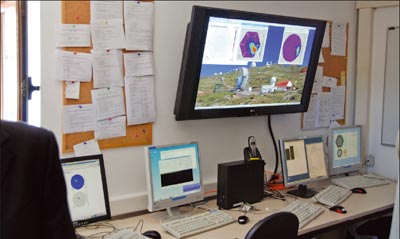
In designing MAGIC-II, the collaboration has benefited both from the experience with MAGIC-I and from technological developments. While the mounts of the two telescopes are essentially the same, the differences lie in the reflecting surface and in particular in the PMTs for the “camera”. MAGIC-II has the same overall surface as MAGIC-I, but is made of fewer, larger plates: 140 1m2 diamond-milled aluminium plates, with 100 additional coated glass mirrors at the outer edges. While the aluminium mirrors have some excellent properties, their technology is not easy to extend to mass production. For MAGIC-II the collaboration turned to glass mirrors and formed a partnership with industry to trial the production of a total of 100 m2.
The camera for MAGIC-II has more smaller-size PMTs of a new design with 10% higher quantum efficiency. MAGIC-I has 396 1″ PMTs to cover the inner area, surrounded by 180 1.5″ PMTs for the outer region. With 1039 1″ PMTs, the MAGIC-II camera covers the same area with more pixels and hence has higher resolution.
Working alone in a special low-energy mode, MAGIC-I has already observed gamma rays down to 25 GeV. Operating in unison, the two telescopes will provide better coverage of such low energies and see deeper into the Universe. The pioneering space-borne EGRET now has a more powerful successor in the Large Area Telescope (LAT) on the recently launched Fermi Gamma-Ray Space Telescope, which has an energy range from 20 MeV up to 300 GeV. With the MAGIC twins and the Fermi-LAT, Lorenz’s dream of closing the energy gap is coming close to realization.
The MAGIC collaboration currently consists of some 150 researchers from 24 institutes in Croatia, Bulgaria, Finland, Germany, Italy, Poland, Spain, Switzerland and the US.






